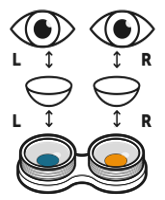Our Orthokeratology Lenses


Free yourself from your glasses during the day, by correcting your myopia at night!
Orthokeratology is a fully reversible method of compensating for myopia and myopic control. The lenses are worn overnight to remodel the curvature of the cornea. They are removed in the morning, allowing clear vision without correction during the day.
Who is it for?
Children and teenagers : AMC Kids
- Myopic control
- Compensation for myopia and astigmatism
- Improved visual acuity and field of vision
Adults : AOK
- Compensation for myopia and astigmatism
- Lens wearers complaining of discomfort (dryness)
- Sports activities
- Lens wearers complaining of discomfort
- Amélioration de l’acuité et du champ visuel
Why control myopia?
An increase of one diopter in myopia increases the risk of retinal complications by 40% over the course of a lifetime. Orthokeratology lenses are an ideal ally in the fight against ocular pathologies in the highly myopic.
- Lim R, Mitchell P, Cumming RG. Refractive Associations with Cataract: the Blue Mountains Eye Study. Invest Ophthalmol Vis Sci 1999;40:3021-6.
- Mitchell P, Hourihan F, Sandbach J, Wang JJ. The relationship between glaucoma and myopia: the Blue Mountains Eye Study. Ophthalmol 1999;106:2010-5. The Eye Disease Case-Control Study Group. Risk Factors for Idiopathic Rhegmatogenous Retinal Detachment. Am J Epidemiol 1993;137:749-57.
- Li X. Incidence and epidemiological characteristics of rhegmatogenous retinal detachment in Beijing, China. Ophthalmol 2003;110:2413-7. Via Clinical Myopia Profile
- Prevalence of macular complications related to myopia – Results of a multicenter evaluation of myopic patients in eye clinics in France. Nicolas Leveziel,1,2,3,4,5 Simon Marillet,2,6 Quentin Dufour,1,2 Bentaleb,7 Francois Pelen,7 Pierre Ingrand4,6 and Rupert Bourne. Acta Ophtalmol. 2020: 98: e245-e251

range

Myopia Control
Material : Dk 200 (orange and blue)
Wear : Night
Care :
Hydrogen peroxide solution + LCS Clean
Or RGP Multipurpose solution + Enzymatic tablets (for a deaper disinfection)

Classical orthokeratology
Material : Dk 200 (orange or blue)
Wear : Night
Care :
Hydrogen peroxide solution + LCS Clean
Or RGP Multipurpose solution + Enzymatic tablets (for a deaper disinfection)
 To differentiate orthokeratology lenses, the right lens is tinted orange by default and the left lens blue. However, you can invert these colours to suit the patient’s preference.
To differentiate orthokeratology lenses, the right lens is tinted orange by default and the left lens blue. However, you can invert these colours to suit the patient’s preference.
